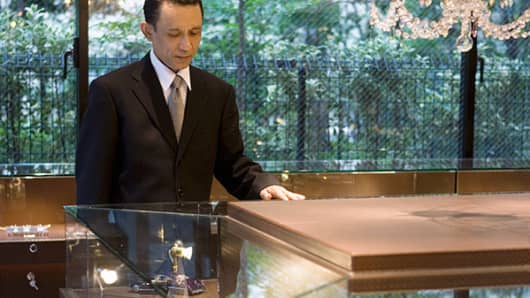Most men might balk at spending $600 on a pair of Dior sneakers but for U.S. shoppers like Ephraim, an upbeat 30-year-old, such indulgences are becoming increasingly commonplace.
Ephraim is the kind of man who gives luxury goods makers high hopes that the U.S. market can fuel future growth, as China runs out of steam and demand in Europe sags.
"There is a cultural shift," Ephraim says while browsing at Saks' New York City flagship. "Men are becoming more fashion forward."
The growing appeal of luxury goods to men and increased confidence among affluent spenders as the U.S. economy and asset prices recover have boosted sales and encouraged luxury brands to step up their investments in the United States.
More foreign shoppers are also thronging stores as the U.S. government eases visa restrictions to attract more tourists.
Luxury spending in the United States collapsed after the 2008 financial crisis but roared back by 2012. Last year, the world's No.1 and No.3 luxury groups LVMH and PPR saw higher growth rates in the United States than in China for the first time in years.
Sales in the Americas are expected to grow 5-7 percent this year, versus 6-8 percent in mainland China and 0-2 percent in Europe, according to consultancy Bain & Co.
Evidence is already showing through. Ralph Lauren this week forecast U.S. sales growth of 4-7 percent while high-end department store Saks reported quarterly sales up 5.9 percent, almost double what analysts had forecast.
"(There is) renewed confidence, a genuine rebound in fashion and luxury consumption," said Sidney Toledano, head of French fashion house Christian Dior, part of LVMH.
Growth Spurt
Major brands like Prada, Hermes, Burberry, and Hugo Boss are opening shops or expanding existing ones in the United States, and are stepping up their advertising spend.
In July, Alexander McQueen will open a 3,900-foot store on New York's Madison Avenue. Next year, Burberry plans to launch a new flagship on Rodeo Drive in Beverly Hills.
LVMH and PPR, soon to be renamed Kering, are also expanding in the United States while putting the brakes on China, which had been the major driver for luxury sales until last year.
"I think the U.S. holds a lot more potential than people believe while the focus has very much been on the BRIC (Brazil, Russia, India, China) countries," said Robert Chavez, head of U.S. operations at Hermes.
The French group, which opened its only shop dedicated to men on Madison Avenue in 2010, now makes about 15 percent of its sales in the United States, up from 10 percent five years ago. China, Hong Kong, Taiwan and Macao account for 20 percent.
"We have noticed a rise in men's purchases, particularly in the last two years," said Chavez. Ties, shoes and $8,000 custom-made three-piece cashmere suits are all doing equally well.
In the 212 billion euro luxury market as a whole, the United States outguns China, even before the new growth spurt. Bain & Co. values the U.S. market at 59 billion euros, Europe at 74.2 billion and China-Hong Kong around 22 billion.
Tourists Are Coming
PPR boss Francois-Henri Pinault reckons that rising numbers of tourists to the United States will enable it to narrow the gap with Europe, where visitors account for about half of luxury sales. That contrasts with 15-20 percent in the United States.
"We will never have as many tourists as in Europe but I think that ratio could reach 30 percent over the next few years," said Milton Predaza, chief executive of Luxury Institute, a U.S. consultancy.
In 2010, 6 million tourists from Brazil, India and China flew to Western Europe compared with 2.6 million to the United States. Travel agents say U.S. visa approvals require more proof of employment history and finances than for France or Italy.
The United States would earn $20 billion more from luxury sales if it had as many tourists from emerging markets as Europe, New York-based brokerage International Strategy & Investment Group (ISI) estimates.
The State Department says it has cut the wait for a visa-related interview in Brazil, where most U.S. luxury shopping tourists come from, to two days. Clerks at Saks said they had noticed an increase in Brazilian tourists.
The State Department also plans to waive interviews for some visa applicants and is expanding or building new consulates in China and Brazil.
Tourism from China is expected to more than triple to 3.9 million people by 2017 from 2011. Tourism from Brazil is forecast to rise 83 percent to 2.8 million, according to the U.S. Department of Commerce.
"We have not had a major breakthrough yet. However, it is moving in the right direction," said Omar Saad, senior managing director and head of the luxury team at ISI.
The appeal of America to Brazilians is twofold—it is closer than Europe and prices are much lower than at home. A Burberry man's coat costs $3,100 in Sao Paulo against $995 at the New York flagship on 57th street.
Rise of 'Henrys'
Pam Danziger, president of marketing consulting firm Unity Marketing and author of studies on the U.S. luxury industry, believes growth is also being driven by what she calls HENRYs — "high earning, not rich yet" Americans making $100,000-$249,000 a year. She estimates about 24.2 million households are HENRYs.
To capture those buyers, brands are now expanding beyond New York, which accounts for a third of U.S. luxury sales, and the next two main cities of Los Angeles and Miami.
Last month, Hermes opened in Greenwich, Conn.—an area popular with financial professionals and their families—and plans to expand in cities like L.A., Miami, Houston, Dallas and Boston over the next two years.
PPR's brands, which include Balenciaga, Gucci and Stella McCartney, are looking at Dallas, Atlanta, Chicago, Miami, Orlando and Philadelphia.
"The U.S. is an emerging country when it comes to luxury," said Boston Consulting Group senior partner Jean-Marc Bellaiche.
_ By Reuters


